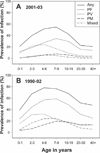Changing patterns of Plasmodium blood-stage infections in the Wosera region of Papua New Guinea monitored by light microscopy and high throughput PCR diagnosis
- PMID: 17038678
- PMCID: PMC3728901
Changing patterns of Plasmodium blood-stage infections in the Wosera region of Papua New Guinea monitored by light microscopy and high throughput PCR diagnosis
Abstract
In Papua New Guinea (PNG), complex patterns of malaria commonly include single and mixed infections of Plasmodium falciparum, P. vivax, P. malariae, and P. ovale. Here, we assess recent epidemiologic characteristics of Plasmodium blood-stage infections in the Wosera region through four cross-sectional surveys (August 2001 to June 2003). Whereas previous studies performed here have relied on blood smear/light microscopy (LM) for diagnosing Plasmodium species infections, we introduce a newly developed, post-polymerase chain reaction (PCR), semi-quantitative, ligase detection reaction-fluorescent microsphere assay (LDR-FMA). A direct comparison of the two methods for > 1,100 samples showed that diagnosis was concordant for > 80% of the analyses performed for P. falciparum (PF), P. vivax (PV), and P. malariae (PM). Greater sensitivity of the LDR-FMA accounted for 75% of the discordance between diagnoses. Based on LM, the prevalence of blood-stage PF, PV, and PM infections was found to be markedly reduced compared with an early 1990s survey. In addition, there were significant shifts in age distribution of infections, with PV becoming the most common parasite in children < 4 years of age. Consistent with previous studies, prevalence of all Plasmodium species infections increased significantly in samples analyzed by the PCR-based LDR-FMA. This increase was most pronounced for PM, PO, and mixed infections and in adolescent (10-19 years) and adult age groups, suggesting that LM may lead to under-reported prevalence of less common Plasmodium species, infection complexity, and a skewed distribution of infections towards younger age groups. This study shows that the application of LDR-FMA diagnosis in large epidemiologic studies or malaria control interventions is feasible and may contribute novel insights regarding the epidemiology of malaria.
Figures




References
-
- Papua New Guinea National Health Plan 2001–2010. Port Moresby: Papua New Guinea Ministry of Health; 2000.
-
- Peters W. Studies on the epidemiology of malaria in New Guinea. 1. Holoendemic malaria—a clinical picture. Trans R Soc Trop Med Hyg. 1960;54:242–249. - PubMed
-
- Peters W, Standfast HA. Studies on the epidemiology of malaria in New Guinea. 2. Holoendemic malaria—the entomological picture. Trans R Soc Trop Med Hyg. 1960;54:249–254. - PubMed
-
- Cattani JA, Tulloch JL, Vrbova H, Jolley D, Gibson FD, Moir JS, Heywood PF, Alpers MP, Stevenson A, Clancy R. The epidemiology of malaria in a population surrounding Madang, Papua New Guinea. Am J Trop Med Hyg. 1986;35:3–15. - PubMed
Publication types
MeSH terms
Substances
Grants and funding
LinkOut - more resources
Full Text Sources
Medical
